

Home - Learning Designs - Products of the AUTC project on ITC-based learning designs. A Simple Guide To 4 Complex Learning Theories. Instructional Design Models. Instructional Design Models Models, like myths and metaphors, help us to make sense of our world.
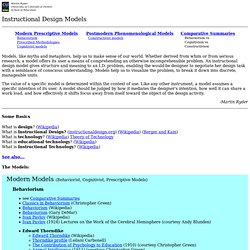
Whether derived from whim or from serious research, a model offers its user a means of comprehending an otherwise incomprehensible problem. An instructional design model gives structure and meaning to an I.D. problem, enabling the would-be designer to negotiate her design task with a semblance of conscious understanding. Models help us to visualize the problem, to break it down into discrete, manageable units. ePrimer series. This E-Primer series places e-learning in a context of learning theory, institutional development, and instructional design.
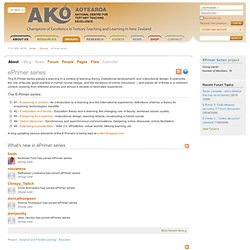
Cognition - The eLearning Coach: Instructional Design and eLearning. Applying Constructivist and Objectivist Learning Theories in the Design of A Web-Based Course: Implications for Practice. Applying Constructivist and Objectivist Learning Theories in the Design of A Web-Based Course: Implications for Practice Mahnaz Moallem, Ph.D.
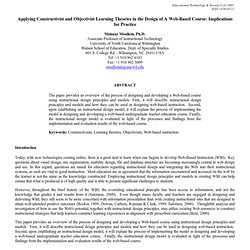
Associate Professor of Instructional Technology University of North Caroloina at Wilmington Watson School of Education, Dept. of Specialty Studies 601 S. College Rd. , Wilmington, NC 28411 USA Tel: +1 910 962 4183 Fax: +1 910 962 3609 moallemm@uncwil.edu Introduction Today, with new technologies coming online, there is a great deal to learn when one begins to develop Web-Based Instruction (WBI).
However, throughout the brief history of the WBI, the overriding educational principle has been access to information, and not the knowledge that guides it and results from it (Salomon, 2000). Learning Needs Analysis. Engagingdistancestudentsinlearning. LSRC_LearningStyles. Learning Styles Don't Exist. Accessibility. Universal Design for Learning: Online Tutorial. Presuming Competence By Design • A Tutorial for Systems, Environment, Curricular, and Materials Design in Learning Systems Requirements While there are many ideas and concepts that translate from classroom practice to online practice (yes, good objectives and multimodal presentations and flexible assessments are important in all environments), there may be some things that are different or that can be done differently in online environments.
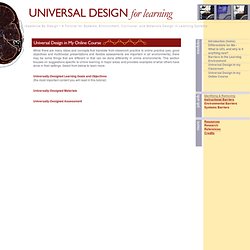
This section focuses on suggestions specific to online learning in major areas and provides examples of what others have done in their settings. Select from below to learn more: Accessibility principles - Inclusive Learning Design Handbook. What Makes Content Accessible?
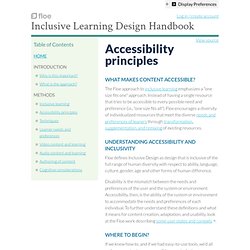
The Floe approach to inclusive learning emphasizes a "one size fits one" approach. Instead of having a single resource that tries to be accessible to every possible need and preference (i.e., "one size fits all"), Floe encourages a diversity of individualized resources that meet the diverse needs and preferences of leaners through transformation, supplementation, and remixing of existing resources. Understanding Accessibility and Inclusivity Floe defines Inclusive Design as design that is inclusive of the full range of human diversity with respect to ability, language, culture, gender, age and other forms of human difference. Disability is the mismatch between the needs and preferences of the user and the system or environment. Where to Begin?
If we knew how to, and if we had easy-to-use tools, we'd all make our content more accessible, more inclusive, more adaptable, and more configurable to individual learner needs. Universal instructional design principles for Moodle. Tanya Elias Athabasca University, Canada Abstract The paper identifies a set of universal instructional design (UID) principles appropriate to distance education (DE) and tailored to the needs of instructional designers and instructors teaching online.
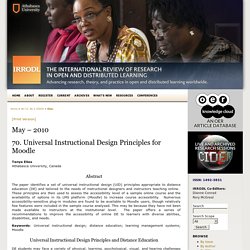
These principles are then used to assess the accessibility level of a sample online course and the availability of options in its LMS platform (Moodle) to increase course accessibility. Numerous accessibility-sensitive plug-in modules are found to be available to Moodle users, though relatively few features were included in the sample course analysed. This may be because they have not been made available to instructors at the institutional level. User Interface. Learning Development Cycle. Learning Development Cycle: Bridging Learning Design and Modern Knowledge Needs July 12, 2005 George Siemens A printable, MS Word verion of this article is available here.
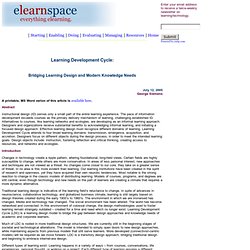
Abstract. Creating learning materials for open and distance learning: a handbook for authors & instructional designers. Description This handbook has been written for anyone who plans and writes learning materials for use in open and distance learning (ODL).

Anyone who is interested in producing better ODL materials will find something of value in this handbook, but the three main target audiences are: teachersinstructional designerswriters ODL materials are sometimes prepared by individuals, but more often by small teams made up of people with skills such as curriculum design, instructional design, tutorial support and print or web design skills. This handbook focuses on the instructional design part of the process, although some of the other aspects are dealt with in part. Evaluation. Online Course Evaluation Rubrics - GSLIS Wiki. There are several different rubric-based online course evaluation programs run by individual universities, institutions, and for-profit enterprises.
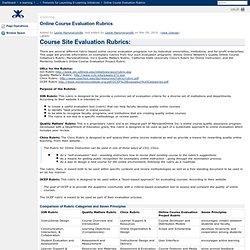
This page will provide information on exemplary rubrics from four such evaluation programs: Illinois Online Network's Quality Online Course Initiative's Rubric; MarylandOnline, Inc's Quality Matters Rubric; California State University Chico's Rubric for Online Instruction; and the Monterey Institute's Online Course Evaluation Project Rubric. Rubric for Online Instruction. Higher Ed Program> Program Rubric. The Quality Matters Higher Education Rubric, Fifth Edition, 2014 is a set of 8 General Standards and 43 Specific Review Standards used to evaluate the design of online and blended courses.

The Rubric is complete with Annotations that explain the application of the Standards and the relationship among them. A scoring system and set of online tools facilitate the review by a team of Peer Reviewers. Unique to the Rubric is the concept of alignment. How Interactive are YOUR Distance Courses. Moodle design. Some criteria to review when considering a plugin. Although for my plugin reviews I do not do a comprehensive analysis, this is something I use in my consulting and training and recommend to people to think about these type of issues when considering implementing a 3rd party plugin. There are many great 3rd-party plugins available for Moodle. However, it is important to assess the suitability and reliability of the plugin before adopting it. The list in the linked document is not exhaustive as there may be more or fewer questions depending on the individual installation and organisation.
Some hosting providers may have already have audited the plugin and publish a list of ones they approve for their hosting platform - Remote-Learner for example. However. as although something may be technically okay, the suitability and cost implications may be something to make you think. Question: Has it got a Moodle Docs page. Question: Do they (the author)work for an established Moodle development team (Moodle partner, the OU, or HQ for example)?
A Moodle 2 version of the Moodle Tool Guide. Many of you will have used and maybe still use Joyce Seitzinger’s Moodle Tool Guide (@catspyjamasnz) which she released nearly two years ago. As her blog mentions since then people have released twelve translations of the guide into Basque, Brazilian Portuguese, Catalan, Croatian, Dutch, French, German, Hebrew, Norwegian, Portuguese, Slovene and Spanish. There has also been some adaptations for specific institutions and also for colour blind users and other LMS like blackboard and Dokoes. * All of these variations are linked from her blog. A Moodle 2 version So last year I had put together a Moodle 2 version which included the tools as they were now in Moodle 2. I had not released it, but as I have given it to some people in the meantime, I thought I better put it up so people can use it or comment on it, suggest changes and so on.
So it is now added to SlideShare where you can download, but you can also download the PDF and the Powerpoint here All feedback & corrections welcome. Front Page Settings in Moodle 2. Best practices in Moodle Course Design. Templates and software. Downloads - LDSE. The Learning Designer software is pre-release and is a prototype for demonstration purposes only. We can't warrant that it will work without defects and you should not use it for any work that you can't afford to lose. We are regularly releasing updates to the software which may not be backward-compatible, as the file format for import and export is still under review. Thus, any work you do in a given version may not be compatible with future versions. You may encounter bugs while you use the software or it may behave erratically, as it is a prototype.
Tivity: 20 minutes: Course Map. As part of our Learning Design/Course Business Models work we have been developing a number of views of a course. One is a Course Map (or at a glance) view, which represents the course in terms of four categories: Content and ActivitiesCommunication and CollaborationGuidance and SupportReflection and Demonstration This essentially is a refinement of an earlier view which was based on five categories.
Task Using the Course map guide, fill in each of the 6 boxes to provide an ‘at a glance’ representation of your module or course (10mins). What you need Course Map guide. Respond Consider the following questions: DOWNLOAD PACK - ALL RESOURCES - Viewpoints Resources - University of Ulster - Technology Facilitated Learning Wiki. Explore, Describe, Apply - Guide Design. Models. Conole learning design_final. Best Practice Models. Are you thinking about using technology to support learning and teaching? Do you want to get the best out of Blackboard to support your students? Four Doors for Busy Non-Dummies (Learning 2.0) Russ Powell, one of Sun's instructional designers, has written a nice summary of the Four Doors approach to eLearning, created by Dr.
Sivasailam Thiagarajan--Thiagi for short. Quality branded consortia. Find out about Quality branded consortia, a tertiary education scenario where there is collaboration across organisations, as depicted by larger geometric shapes that start to spread beyond the tertiary environment. About the scenario. Design Principles. Table of Contents - Seven Principles' Library of Ideas for Teaching and Learning with Technology.